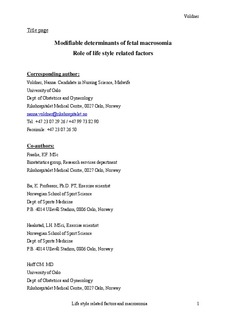| dc.contributor.author | Voldner, Nanna | |
| dc.contributor.author | Frøslie, Kathrine Frey | |
| dc.contributor.author | Bø, Kari | |
| dc.contributor.author | Haakstad, Lene Annette Hagen | |
| dc.contributor.author | Hoff, Camilla | |
| dc.contributor.author | Godang, Kristin | |
| dc.contributor.author | Bollerslev, Jens | |
| dc.contributor.author | Henriksen, Tore | |
| dc.date.accessioned | 2009-04-02T12:19:18Z | |
| dc.date.issued | 2008-03-06 | |
| dc.identifier | Seksjon for idrettsmedisinske fag / Department of Sports Medicine | |
| dc.identifier.citation | Acta Obstetricia et Gynecologica Scandinavica. 2008, 87(4), 423-429 | en |
| dc.identifier.issn | 1600-0412 | |
| dc.identifier.uri | http://hdl.handle.net/11250/170521 | |
| dc.description | I Brage finner du siste tekst-versjon av artikkelen, og den kan inneholde ubetydelige forskjeller fra forlagets pdf-versjon. Forlagets pdf-versjon finner du på www.informaworld.com: http://dx.doi.org/10.1080/00016340801989825 / In Brage you'll find the final text version of the article, and it may contain insignificant differences from the journal's pdf version. The original publication is available at www.informaworld.com: http://dx.doi.org/10.1080/00016340801989825 | en |
| dc.description.abstract | Background: Newborn macrosomia is associated with both short- and long-term health risks for the infant, and increases the prevalence of birth complications. Parity, maternal age and gender of the child are known variables that influence fetal growth. The purpose of the present investigation was to evaluate prospectively the contributions of modifiable maternal predictors of fetal macrosomia (≥4,200 g), which included lifestyle-related factors, such as nutritional intake, physical activity, and plasma glucose values, in addition to overweight and pregnancy weight gain. Methods. Some 553 women were followed through pregnancy. Predictive variables were subjected to univariate and multiple logistic regression analysis. Among these were: body mass index (BMI), weight gain, maternal subcutaneous fat (mm), fasting and 2-h plasma glucose, self-reported physical activity before and during pregnancy, and nutritional intake of macronutrients. Gestational age, parity and gender were also included in the model. All continuous variables were dichotomized using the upper quartile as the cut-off point in most cases. Results. If physical activity was left out of the analyses, BMI, weight gain, plasma glucose and gestational age were independent determinants of macrosomia. After including low level pre-gestational physical activity in the model, we found that this was now a significant determinant of delivering a macrosomic infant with an OR=2.9 (95% CI: 1.9, 7.3). Conclusion: The present study indicates that a low level of pre-gestational physical activity adds to the modifiable determinants of newborn macrosomia. | en |
| dc.format.extent | 175285 bytes | |
| dc.format.mimetype | application/pdf | |
| dc.language.iso | eng | en |
| dc.publisher | Informa Healthcare | en |
| dc.subject | fetal macrosomia | en |
| dc.subject | physical activity | en |
| dc.subject | body mass index | en |
| dc.subject | nutritional intake | en |
| dc.subject | plasma glucose | en |
| dc.title | Modifiable determinants of fetal macrosomia: role of lifestyle-related factors | en |
| dc.type | Peer reviewed | en |
| dc.type | Journal article | en |
| dc.subject.nsi | VDP::Medical disciplines:700 | |
| dc.source.pagenumber | 423-429 | en |
| dc.source.volume | 87 | en |
| dc.source.journal | Acta Obstetricia et Gynecologica Scandinavica | en |
| dc.source.issue | 4 | en |
